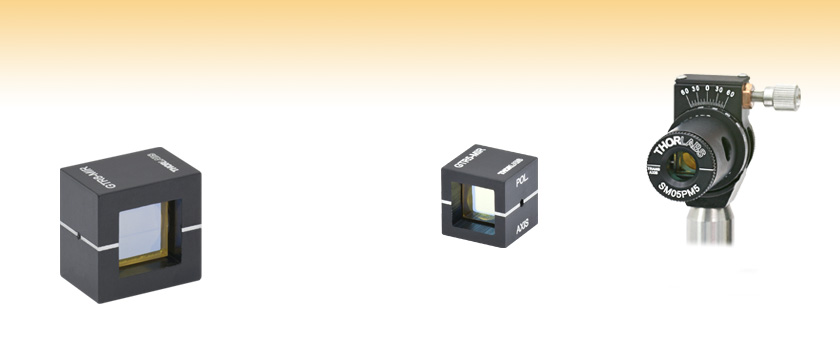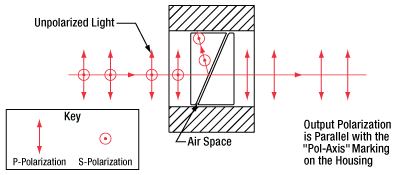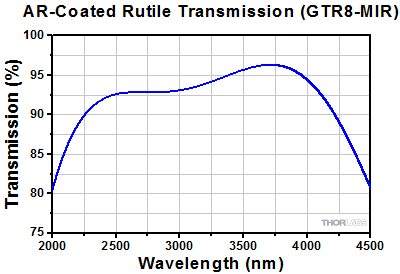Rutile TiO₂ Polarizers

- Extinction Ratio: 100 000:1
- 2.2 - 4 µm Wavelength Range
- Transmits Linearly Polarized Light
GTR8-MIR
GTR5-MIR
GTR5-MIR Mounted in a
PRM1GL10 Rotation Mount

Please Wait

Click to Enlarge
Figure 1.1 Side View of a Rutile Polarizer
Unpolarized Light Enters, S-Polarized Light is Reflected
and Absorbed, P-Polarized Light is Transmitted
Features
- 100 000:1 Extinction Ratio
- 2.2 - 4 µm Wavelength Range
- AR-Coated Entrance and Exit Faces for the Entire Wavelength Range
Our Rutile (TiO2) Polarizers offer extremely pure polarization of light with a 100 000:1 extinction ratio. They are meant for use with lasers in the 2.2 - 4 µm wavelength range and have an air-spaced design. Please note that Rutile Polarizing Prisms are designed to work with well collimated light beams. Divergent beams will produce multiple output beams.
Our Rutile Polarizing Prisms utilize a Glan-Foucault design, with two right-angle rutile prisms spaced slightly apart to create a gap. As rutile is a positively birefringent crystal, as opposed to a negatively birefringent material like calcite, the ordinary, rather than the extraordinary ray, is transmitted. When unpolarized light enters the polarizer, the beam is split into two polarized rays at the internal interface. Due to the difference in refractive indices, no and ne, the ordinary polarization component (p-polarized light) passes straight through the polarizer without deviation, while the extraordinary polarization component (s-polarized light) is deflected by total internal reflection and absorbed by the polarizer housing. The output polarization is parallel with the Polarization Axis line on the polarizer housing.
Our rutile polarizers have λ/4 polished optical faces with a Ø5 mm or Ø8 mm clear aperture. Additionally, the entrance and exit faces are AR-Coated over the entire wavelength range. They include a square aluminum housing with the polarization axis clearly marked. The GTR5 has a 9.6 mm square housing, while the GTR8 has a 15.9 mm square housing.
The GTM5 is compatible with the SM05PM5 and PRM05GL5 mounts, while GTM8 is compatible with the SM1PM10 and PRM1GL10 mounts.
| Item # | GTR5-MIR | GRT8-MIR |
|---|---|---|
| Material | TiO2 (Rutile)a | |
| Extinction Ratiob | 100 000:1 | |
| Wavelength Range | 2.2 - 4 µm | |
| Transmission | 93% Average within Specified Wavelength Range | |
| Acceptance Angle (Typical) | ±2.0° | |
| Beam Deviation | <3 arcmin | |
| Surface Quality | 20-10 Scratch-Dig | |
| Surface Flatness (@633 nm) | λ/4 | |
| AR Coating (Entrance and Exit Windows) | Ravg < 1% from 2.2 - 4 µm | |
| Clear Aperture | Ø5 mm | Ø8 mm |
| Housing | Anodized Aluminum | |
| Housing Dimensions (l x w x h) | 9.1 mm x 9.5 mm x 9.5 mm | 10.7 mm x 15.9 mm x 15.9 mm |
| Recommended Mounts | SM05PM5 PRM05GL5 |
SM1PM10 PRM1GL10 |
| Posted Comments: | |
Giorgio Guercio
(posted 2023-06-26 09:16:30.83) Hello,
Is it possible to obtain a transmittance spectrum that cover the wavelength range between 1000-2000 nm for the GTR5-MIR device?
Best regards jpolaris
(posted 2023-06-26 02:25:43.0) Thank you for contacting Thorlabs. GTR5-MIR uses a Rutile (TiO2) substrate, which has a typical transmission of ~70% - 73% within the 1000 nm - 2000 nm range. I have reached out to you directly with extended transmission data for this substrate. More information about Rutile can be found at the following page.
https://www.thorlabs.com/newgrouppage9.cfm?objectgroup_id=6973&tabname=Rutile. jean-christophe.delagnes
(posted 2016-03-22 21:48:46.147) Rutile Sellmeier equation for both (o) and (e) wave is the one established by Devore in 1951. This formula is only specified for wavelength in the 0.43 - 1.53 um range while GTR8-MIR is specified for 2.2 - 4 um? How can I estimate the GVD of this polarizer at 3 um (ultrafast application)? Can you update the product page with GVD in the ragne of interest? besembeson
(posted 2016-03-24 04:35:47.0) Response from Bweh at Thorlabs USA: That is correct. We will review the plot we have that extends to 5um. I will contact you regarding the GVD around 3um. |
Polarizer Selection Guide
Thorlabs offers a diverse range of polarizers, including wire grid, film, calcite, alpha-BBO, rutile, and beamsplitting polarizers. Collectively, our line of wire grid polarizers offers coverage from the visible range to the beginning of the Far-IR range. Our nanoparticle linear film polarizers provide extinction ratios as high as 100 000:1. Alternatively, our other film polarizers offer an affordable solution for polarizing light from the visible to the Near-IR. Next, our beamsplitting polarizers allow for use of the reflected beam, as well as the more completely polarized transmitted beam. Finally, our alpha-BBO (UV), calcite (visible to Near-IR), rutile (Near-IR to Mid-IR), and yttrium orthovanadate (YVO4) (Near-IR to Mid-IR) polarizers each offer an exceptional extinction ratio of 100 000:1 within their respective wavelength ranges.
To explore the available types, wavelength ranges, extinction ratios, transmission, and available sizes for each polarizer category, click More [+] in the appropriate row below.
| Wire Grid Polarizers |
|---|
| Film Polarizers |
|---|
| Beamsplitting Polarizers |
|---|
| alpha-BBO Polarizers |
|---|
| Calcite Polarizers |
|---|
| Quartz Polarizers |
|---|
| Magnesium Fluoride Polarizers |
|---|
| Yttrium Orthovanadate (YVO4) Polarizers |
|---|
| Rutile Polarizers |
|---|
 Products Home
Products Home






 Rutile TiO2 Polarizers
Rutile TiO2 Polarizers